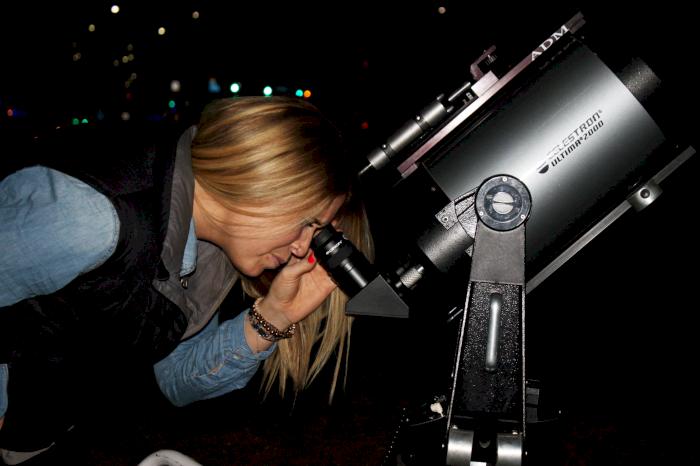STEM in DSM: Astronomical organization invites the public to explore the universe
- Thursday April 16 2015
- STEM in DSM
The Hippo Nebula. You won’t find it in the index of any science book. But for Doug Rudd, vice president of the Des Moines Astronomical Society (DMAS), it’s proof of a major scientific breakthrough: the A-ha! moment.
When Rudd visits elementary classrooms, he introduces the imaginative side of space. Before he reveals the official name of a galactic object, Rudd encourages students to create their own — including the Hippo Nebula, one second-grader’s interpretation of the Eagle Nebula.
“I said, ‘Well, what would you call it?’ She said, ‘I’d call it the Hippo Nebula!’ Then she pointed out, ‘Here’s its head, here’s its ear and here’s its tail and its legs. And look, there’s a squirrel riding on that hippo!’”
DMAS encourages beginning astronomers of all ages to own the star-gazing experience.
“I always like to encourage that when you’re looking up at the night sky, focus on what you see up there,” Rudd said. “Don’t just go by what everybody else says. Invent your own things you see in the sky. Get that imagination working.”
Engaging the imagination is key in creating interest in astronomy. That interest has benefits beyond beautiful telescope images — it fosters an advocate community for dark skies.
This week is especially important in the fight against light pollution, as astronomers across the globe celebrate International Dark Sky Week.
“Awareness of astronomy gives us more opportunities to talk about the need for dark skies,” Rudd said. “City governments and the public rarely consider the implications of big, bright lights. Without public interest in astronomy, they don’t have anything encouraging them to help manage light pollution.”
An A-ha! moment is the first step in creating that community of dark-sky advocates. DMAS engages amateur astronomers of all ages at its weekly public nights from the first Saturday in April through the last Saturday in October at Ashton Observatory in Jasper County. DMAS partners with SCI for monthly Star Party events, too.
The organization also presents astronomy lessons at area libraries, Boy Scout troop meetings and schools.
For Rudd, those lessons often transcend astronomy, igniting interest in STEM along the way. Two weeks ago, he witnessed astronomy’s inspiring power during a visit to a fourth-grade classroom.
After preparing his equipment for the presentation, a group of students returned early from lunch, and one student said to Rudd, “Oh, I don’t really like science.”
But a glimpse into the universe sparked the ultimate A-ha! moment.
“After the presentation, she walked back up to me and she said, ‘I really like science now.’ To that extent, it goes beyond just astronomy,” Rudd said. “It brings some new insight to a young mind that they hadn’t seen before, that science and astronomy can be fun and interesting.”
The Hubble Space Telescope has led the way in that mission, too, providing the public with accessible, stunning images of our solar system and even deep space.
“The biggest thing, of course, is the images Hubble takes are so accessible. NASA, of course, has its Astronomy Picture of the Day. So, over 25 years for 365 days, there are a lot of images it has showed us,” Rudd said. “Hubble has just opened up the world to our unbelievable universe.”
As Hubble and DMAS invite more people to explore the universe beyond Earth, Rudd can count on more A-ha! moments. And those epiphanies are more exciting than any discovery found in the lens of a telescope.
“That’s what I most appreciate about astronomy,” he said. “Yeah, I like to look through the telescope, but to hear the excitement in somebody’s voice that says, ‘Wow, I never thought,’ is amazing.”


